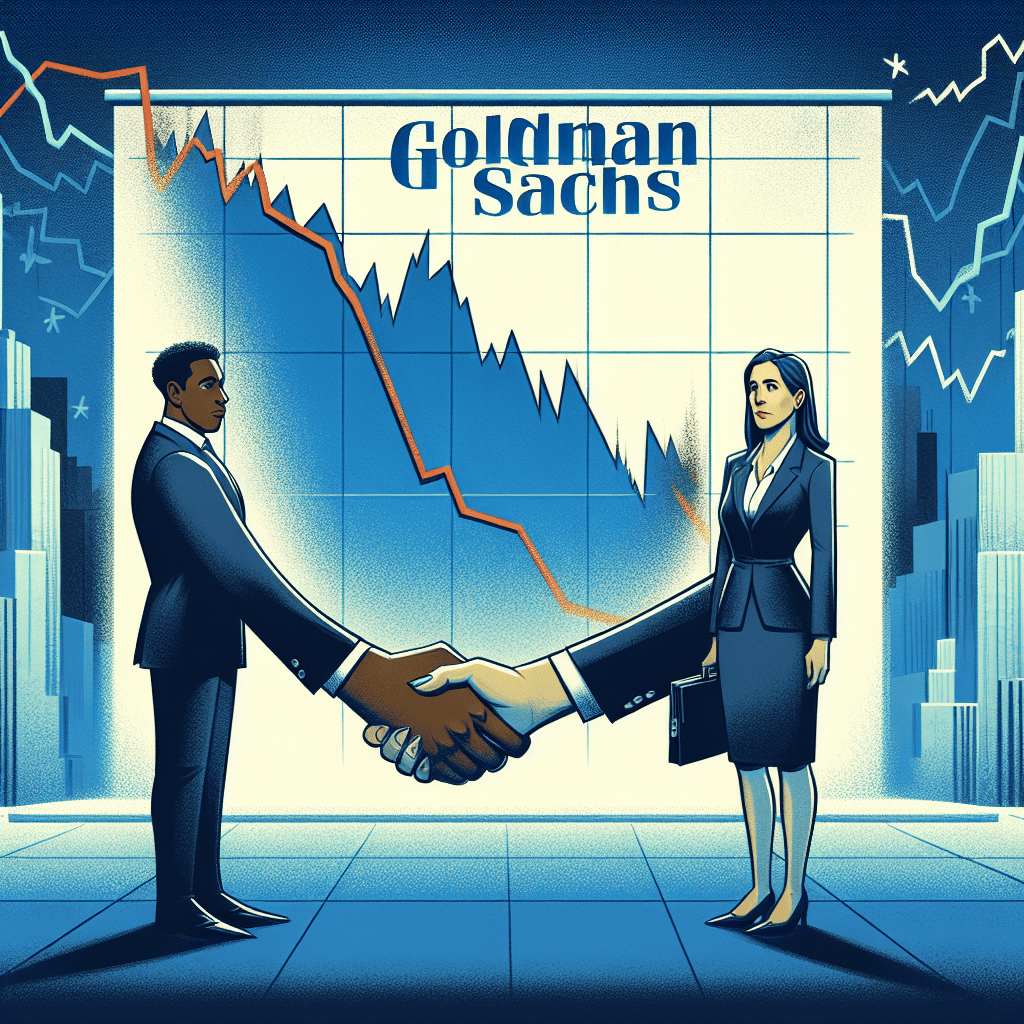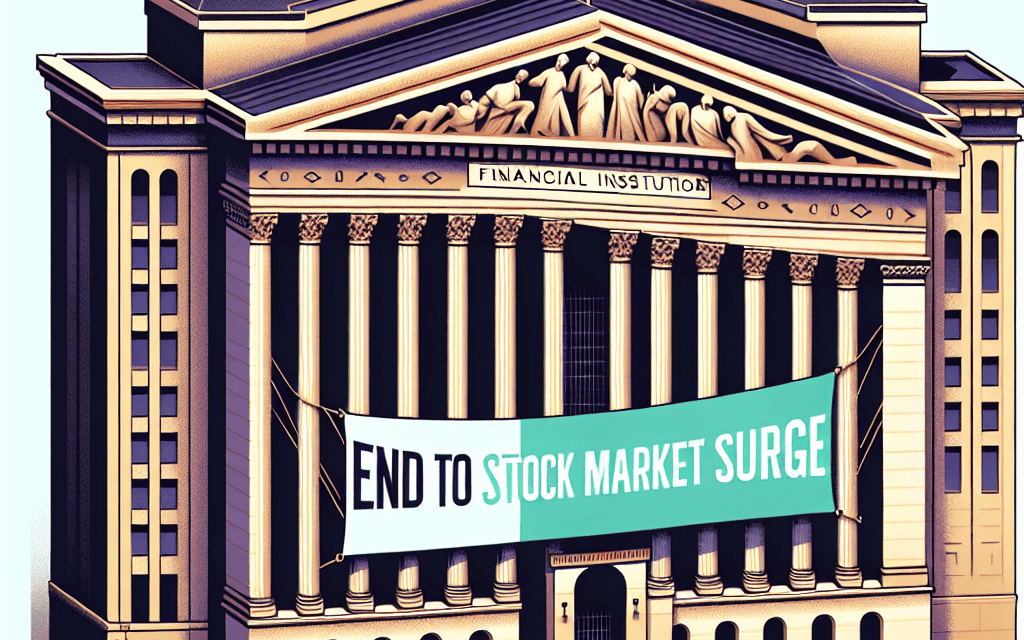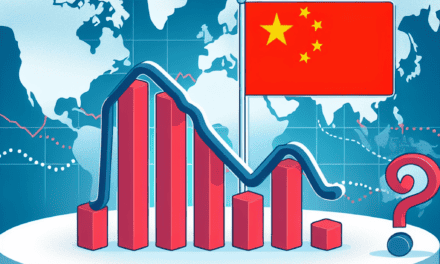“Goldman Sachs Signals: The Bull Run Hits the Brakes.”
Introduction
Goldman Sachs, a leading global investment banking and securities firm, has recently announced the conclusion of the prolonged stock market surge that has characterized the financial landscape in recent years. This declaration marks a pivotal moment for investors and market analysts, as the firm cites a confluence of factors contributing to this anticipated shift. These include tightening monetary policies, geopolitical tensions, and evolving economic indicators that suggest a deceleration in market momentum. As a bellwether for financial trends, Goldman Sachs’ assessment is poised to influence investment strategies and market expectations worldwide, signaling a potential recalibration of asset valuations and risk assessments in the coming months.
Impact Of Goldman Sachs’ Announcement On Global Markets
Goldman Sachs, a leading global investment banking, securities, and investment management firm, recently announced the end of the stock market surge, a declaration that has sent ripples across global markets. This announcement, coming from such a reputable institution, has significant implications for investors, policymakers, and economies worldwide. The firm’s analysis, which is based on a comprehensive evaluation of market trends, economic indicators, and geopolitical factors, suggests that the bullish phase that characterized the stock markets in recent years is drawing to a close. Consequently, this has prompted a reevaluation of investment strategies and economic forecasts across the globe.
In the immediate aftermath of Goldman Sachs’ announcement, stock markets experienced heightened volatility. Investors, who had grown accustomed to the prolonged period of market gains, were suddenly faced with the prospect of a more uncertain future. This shift in sentiment was reflected in the fluctuating stock prices, as market participants scrambled to adjust their portfolios in response to the new outlook. The announcement also led to a surge in trading volumes, as investors sought to capitalize on short-term opportunities or mitigate potential losses. This increased activity underscored the profound impact that Goldman Sachs’ projections have on market behavior.
Moreover, the announcement has prompted central banks and financial regulators to reassess their monetary policies. With the potential end of the stock market surge, there is a growing concern about the broader economic implications, particularly in terms of consumer confidence and spending. Central banks, which have been closely monitoring inflationary pressures and economic growth, may need to recalibrate their strategies to ensure financial stability. This could involve adjusting interest rates or implementing other measures to support economic activity in the face of potential market downturns.
In addition to influencing monetary policy, Goldman Sachs’ announcement has also affected corporate strategies. Companies that have benefited from the stock market surge are now reevaluating their growth plans and capital allocation strategies. For instance, firms that have relied heavily on equity financing may need to explore alternative funding sources, such as debt issuance or strategic partnerships, to sustain their operations and expansion efforts. Furthermore, businesses are likely to adopt a more cautious approach to mergers and acquisitions, given the increased uncertainty surrounding market valuations.
The global nature of financial markets means that the impact of Goldman Sachs’ announcement extends beyond the United States. International markets, particularly those in emerging economies, are also feeling the effects of this development. These markets, which have often mirrored the performance of U.S. stock indices, are now grappling with the potential consequences of a slowdown in global economic growth. As a result, investors in these regions are becoming more risk-averse, leading to capital outflows and currency fluctuations.
In conclusion, Goldman Sachs’ declaration of the end to the stock market surge has far-reaching implications for global markets. The announcement has triggered a wave of volatility, prompting investors to reassess their strategies and central banks to reconsider their monetary policies. Additionally, corporations are reevaluating their growth plans in light of the changing market dynamics. As the world navigates this new economic landscape, the insights provided by Goldman Sachs will undoubtedly continue to shape the decisions of market participants and policymakers alike.
Historical Analysis Of Market Trends Post Goldman Sachs Predictions
In the ever-evolving landscape of global finance, the pronouncements of major financial institutions often serve as pivotal indicators for market participants. Recently, Goldman Sachs, a stalwart in the investment banking sector, declared an end to the current stock market surge, a statement that has reverberated across trading floors worldwide. To understand the potential implications of this declaration, it is instructive to examine historical market trends following similar predictions by Goldman Sachs. This analysis not only provides context but also offers insights into the possible trajectory of the market in the coming months.
Historically, Goldman Sachs has wielded considerable influence over market sentiment. Their forecasts, often grounded in rigorous analysis and comprehensive data, have been known to sway investor behavior significantly. For instance, during the financial crisis of 2008, Goldman Sachs was among the first to predict the severity of the downturn, prompting a wave of caution among investors. Similarly, in the aftermath of the crisis, their optimistic outlook on the recovery played a crucial role in restoring confidence in the markets. These instances underscore the weight that Goldman Sachs’ predictions carry in shaping market dynamics.
Transitioning to more recent history, the post-2010 era offers further examples of the bank’s predictive prowess. In 2015, when concerns about a potential slowdown in China loomed large, Goldman Sachs issued a cautionary note that led to a temporary dip in global markets. However, their subsequent reassessment, which highlighted resilience in emerging markets, helped stabilize investor sentiment. This pattern of initial caution followed by a more nuanced analysis has been a hallmark of Goldman Sachs’ approach, reflecting their ability to adapt to rapidly changing economic landscapes.
In light of these historical precedents, the current declaration by Goldman Sachs warrants careful consideration. The end of a stock market surge, as they suggest, could imply a period of consolidation or even a potential downturn. However, it is essential to recognize that such predictions are not deterministic. Rather, they serve as a framework for investors to assess risk and adjust their strategies accordingly. The market’s response to this latest forecast will likely depend on a confluence of factors, including macroeconomic indicators, geopolitical developments, and corporate earnings reports.
Moreover, it is crucial to acknowledge that while Goldman Sachs’ predictions have often been prescient, they are not infallible. The complexity of global markets means that unforeseen events can alter trajectories in unexpected ways. For instance, the COVID-19 pandemic in 2020 was a stark reminder of how quickly market conditions can change, rendering even the most well-founded predictions obsolete. Therefore, while Goldman Sachs’ declaration may signal a shift in market dynamics, it should be viewed as one of many inputs in a comprehensive investment strategy.
In conclusion, the historical analysis of market trends following Goldman Sachs’ predictions reveals a pattern of significant influence tempered by the inherent unpredictability of financial markets. As investors digest the implications of the bank’s latest declaration, it is imperative to maintain a balanced perspective, considering both historical context and current economic realities. By doing so, market participants can navigate the complexities of the financial landscape with greater confidence and resilience.
Investor Strategies In Response To Goldman Sachs’ Market Outlook
Goldman Sachs, a leading global investment banking, securities, and investment management firm, recently declared an end to the stock market surge that has characterized much of the past decade. This announcement has sent ripples through the investment community, prompting investors to reassess their strategies in light of the anticipated market shift. As the firm’s analysts predict a more subdued market environment, investors are now tasked with navigating this new landscape with caution and foresight.
In response to Goldman Sachs’ market outlook, investors are increasingly considering a shift from growth-oriented strategies to more conservative, value-based approaches. Growth stocks, which have been the darlings of the market during the surge, may no longer offer the same level of returns. Consequently, investors are turning their attention to value stocks, which are typically characterized by lower price-to-earnings ratios and more stable earnings. This shift is not merely a reactionary measure but a strategic pivot to ensure portfolio resilience in the face of potential market volatility.
Moreover, diversification remains a cornerstone of prudent investment strategy, especially in uncertain times. Investors are advised to broaden their portfolios across various asset classes, including bonds, commodities, and real estate, to mitigate risk. Bonds, in particular, are gaining renewed interest as they offer a more predictable income stream and can act as a buffer against stock market fluctuations. Additionally, commodities such as gold and silver are being considered as hedges against inflation and currency devaluation, providing a layer of security in an unpredictable economic environment.
In tandem with diversification, investors are also exploring international markets as a means to capitalize on growth opportunities outside the domestic sphere. Emerging markets, despite their inherent risks, present potential for higher returns due to their rapid economic development and expanding consumer bases. By allocating a portion of their portfolios to international equities, investors can tap into these growth prospects while spreading risk across different geographical regions.
Furthermore, the importance of maintaining liquidity cannot be overstated in the current market climate. Having readily accessible funds allows investors to take advantage of market opportunities as they arise, without the need to liquidate long-term investments at inopportune times. This strategy not only provides flexibility but also positions investors to act swiftly in response to market corrections or downturns.
In addition to these strategic adjustments, investors are increasingly relying on data-driven insights and advanced analytics to inform their decision-making processes. The use of technology in investment management has become indispensable, offering tools for real-time market analysis and risk assessment. By leveraging these resources, investors can make more informed decisions and adapt their strategies to align with evolving market conditions.
In conclusion, Goldman Sachs’ declaration of an end to the stock market surge serves as a pivotal moment for investors to reevaluate their strategies. By embracing value investing, diversifying across asset classes and geographies, maintaining liquidity, and utilizing advanced analytics, investors can navigate the anticipated market shift with greater confidence. While the path forward may be fraught with challenges, a well-considered approach can help safeguard investments and capitalize on new opportunities in this changing economic landscape.
Comparing Goldman Sachs’ Forecast With Other Financial Institutions

Goldman Sachs, a leading global investment banking, securities, and investment management firm, recently declared an end to the stock market surge that has characterized much of the post-pandemic economic recovery. This announcement has sparked considerable interest and debate among investors and financial analysts, prompting comparisons with forecasts from other major financial institutions. As we delve into these comparisons, it is essential to understand the context and rationale behind Goldman Sachs’ projection and how it aligns or diverges from the perspectives of its peers.
To begin with, Goldman Sachs’ forecast is rooted in a comprehensive analysis of various economic indicators and market dynamics. The firm cites factors such as rising interest rates, inflationary pressures, and geopolitical uncertainties as key reasons for its cautious outlook. These elements, according to Goldman Sachs, are likely to dampen investor enthusiasm and curtail the bullish momentum that has driven stock prices to unprecedented heights. Furthermore, the firm emphasizes the potential impact of central bank policies, particularly the Federal Reserve’s stance on monetary tightening, which could further constrain market growth.
In contrast, other financial institutions have offered differing perspectives on the future trajectory of the stock market. For instance, Morgan Stanley has expressed a more optimistic view, suggesting that while market volatility may increase, the underlying fundamentals of the economy remain robust enough to support continued growth. Morgan Stanley points to strong corporate earnings, consumer spending resilience, and technological innovation as factors that could sustain the market’s upward trajectory, albeit at a more moderated pace.
Similarly, JPMorgan Chase has also presented a somewhat positive outlook, albeit with cautionary notes. The bank acknowledges the challenges posed by inflation and interest rate hikes but argues that these factors are already priced into the market to some extent. JPMorgan Chase believes that strategic sector rotation and selective stock picking could offer investors opportunities to capitalize on market fluctuations. This approach underscores the importance of adaptability and vigilance in navigating the evolving financial landscape.
On the other hand, Bank of America has aligned more closely with Goldman Sachs’ cautious stance. The institution highlights the potential for economic slowdown as fiscal stimulus measures wane and supply chain disruptions persist. Bank of America also raises concerns about the sustainability of current valuation levels, suggesting that a market correction could be on the horizon. This perspective resonates with Goldman Sachs’ warning of an impending end to the stock market surge, reinforcing the notion that investors should brace for potential headwinds.
As we compare these forecasts, it becomes evident that while there is a consensus on certain risk factors, the degree of optimism or pessimism varies among financial institutions. This divergence underscores the complexity and unpredictability of financial markets, where multiple variables interact in intricate ways. Investors, therefore, must weigh these differing viewpoints and consider their own risk tolerance and investment strategies.
In conclusion, Goldman Sachs’ declaration of an end to the stock market surge has prompted a reevaluation of market conditions and expectations. By comparing its forecast with those of other financial institutions, we gain a nuanced understanding of the diverse perspectives shaping the investment landscape. As the global economy continues to navigate uncharted waters, the insights and analyses provided by these institutions will remain invaluable in guiding investors through the challenges and opportunities that lie ahead.
The Role Of Economic Indicators In Goldman Sachs’ Market Predictions
Goldman Sachs, a leading global investment banking, securities, and investment management firm, has recently declared an end to the stock market surge that has characterized much of the past decade. This announcement has sent ripples through the financial world, prompting investors and analysts alike to scrutinize the economic indicators that have informed Goldman Sachs’ market predictions. Understanding the role of these indicators is crucial for comprehending the rationale behind such a significant forecast.
Economic indicators are statistical metrics used to gauge the health of an economy, providing insights into future market trends. Goldman Sachs, renowned for its analytical prowess, relies heavily on these indicators to shape its market predictions. Among the most influential are gross domestic product (GDP) growth rates, unemployment figures, inflation rates, and consumer confidence indices. Each of these indicators offers a unique perspective on the economic landscape, and together, they form a comprehensive picture that guides investment strategies.
GDP growth rates are often considered the most direct measure of economic performance. A robust GDP growth rate typically signals a healthy economy, which can lead to increased corporate earnings and, consequently, rising stock prices. However, recent data has shown a deceleration in GDP growth, suggesting that the economy may be losing momentum. This slowdown is a critical factor in Goldman Sachs’ prediction of an end to the stock market surge, as it indicates potential challenges for corporate profitability and investor returns.
In addition to GDP, unemployment figures play a pivotal role in market predictions. Low unemployment rates generally reflect a strong labor market, which can boost consumer spending and drive economic growth. However, the current labor market has shown signs of tightening, with unemployment rates reaching historically low levels. While this might seem positive at first glance, it can also lead to wage inflation, which can erode corporate profit margins and dampen stock market performance. Goldman Sachs has likely considered these dynamics in its assessment of future market conditions.
Inflation rates are another crucial economic indicator that Goldman Sachs monitors closely. Moderate inflation is typically seen as a sign of a growing economy, but excessive inflation can have detrimental effects. Rising inflation can lead to increased costs for businesses and reduced purchasing power for consumers, both of which can negatively impact stock prices. Recent trends have shown an uptick in inflationary pressures, driven by supply chain disruptions and increased demand for goods and services. This development has likely contributed to Goldman Sachs’ cautious outlook on the stock market.
Consumer confidence indices provide additional insights into the economic environment. High consumer confidence usually correlates with increased spending, which can stimulate economic growth and support rising stock prices. However, recent surveys have indicated a decline in consumer confidence, possibly due to concerns about inflation and economic uncertainty. This decline suggests that consumers may become more conservative in their spending habits, potentially leading to slower economic growth and weaker stock market performance.
In conclusion, Goldman Sachs’ declaration of an end to the stock market surge is grounded in a thorough analysis of key economic indicators. By examining GDP growth rates, unemployment figures, inflation rates, and consumer confidence indices, the firm has identified potential headwinds that could hinder future market gains. As investors navigate this evolving landscape, understanding the role of these indicators in shaping market predictions will be essential for making informed decisions.
How Goldman Sachs’ Announcement Affects Emerging Markets
Goldman Sachs’ recent declaration signaling the end of the stock market surge has sent ripples across global financial markets, particularly impacting emerging economies. As one of the most influential financial institutions, Goldman Sachs’ assessments carry significant weight, often shaping investor sentiment and market dynamics. This announcement, therefore, warrants a closer examination of its implications for emerging markets, which are often more vulnerable to shifts in global economic trends.
To begin with, emerging markets have historically been sensitive to changes in the economic policies and forecasts of major financial players. The end of a stock market surge, as predicted by Goldman Sachs, suggests a potential shift in investor behavior, with a possible reallocation of capital away from riskier assets. Emerging markets, characterized by their higher volatility and perceived risk, may experience capital outflows as investors seek safer havens. This could lead to a depreciation of local currencies, increased borrowing costs, and a tightening of financial conditions, all of which could stifle economic growth.
Moreover, the announcement may exacerbate existing challenges faced by emerging markets. Many of these economies are already grappling with high levels of debt, inflationary pressures, and political instability. A downturn in global stock markets could further strain their financial systems, making it more difficult for governments to implement necessary reforms and investments. Additionally, as global investors become more risk-averse, the cost of financing for emerging market companies could rise, potentially leading to a slowdown in corporate investment and expansion.
Furthermore, the potential end of the stock market surge could also impact trade dynamics. Emerging markets often rely heavily on exports to fuel their economic growth. A slowdown in developed economies, which could result from a broader market correction, might lead to reduced demand for exports from emerging markets. This, in turn, could negatively affect their trade balances and economic stability. Additionally, fluctuations in commodity prices, which are closely tied to global economic performance, could further complicate the economic outlook for resource-dependent emerging markets.
On the other hand, it is important to consider that not all emerging markets will be equally affected by Goldman Sachs’ announcement. Some countries have built robust economic frameworks and diversified their economies, making them more resilient to external shocks. These nations may be better positioned to weather the potential storm and could even attract investment as investors seek out relatively stable opportunities within the emerging market landscape. Moreover, countries with strong domestic consumption and less reliance on external financing may find themselves less vulnerable to the anticipated shifts in global capital flows.
In conclusion, while Goldman Sachs’ declaration of the end of the stock market surge presents challenges for emerging markets, it also underscores the importance of resilience and adaptability in an ever-changing global economic environment. Policymakers in these regions must remain vigilant, implementing strategies to mitigate potential risks and capitalize on opportunities that may arise. By strengthening economic fundamentals, diversifying growth drivers, and fostering a stable investment climate, emerging markets can better navigate the uncertainties ahead and continue on their path toward sustainable development. As the global financial landscape evolves, the ability of emerging markets to adapt will be crucial in determining their future economic trajectories.
Long-term Implications Of Goldman Sachs’ Market Surge Declaration
Goldman Sachs, a leading global investment banking, securities, and investment management firm, recently declared an end to the stock market surge that has characterized much of the past decade. This announcement has sent ripples through the financial world, prompting investors and analysts to reassess their strategies and expectations. The implications of this declaration are profound, as it signals a potential shift in the economic landscape that could affect both short-term market dynamics and long-term investment strategies.
To understand the significance of Goldman Sachs’ declaration, it is essential to consider the context in which it was made. Over the past several years, the stock market has experienced an unprecedented rise, driven by a combination of factors including low interest rates, quantitative easing, and robust corporate earnings. This surge has been further fueled by technological advancements and the rapid growth of sectors such as technology and healthcare. However, as the global economy begins to grapple with challenges such as inflationary pressures, geopolitical tensions, and supply chain disruptions, the sustainability of this market rally has come into question.
Goldman Sachs’ announcement reflects a growing consensus among financial experts that the era of easy gains may be drawing to a close. The firm has pointed to several indicators that suggest a cooling of the market, including rising interest rates, which tend to increase the cost of borrowing and can dampen corporate profits. Additionally, the potential for tighter monetary policy by central banks around the world could further constrain liquidity, making it more difficult for companies to access capital and for investors to achieve the high returns they have become accustomed to.
In light of these developments, investors are being urged to adopt a more cautious approach. Diversification, a strategy that involves spreading investments across various asset classes to reduce risk, is being emphasized as a prudent measure. By diversifying their portfolios, investors can potentially mitigate the impact of market volatility and protect their investments from significant downturns. Moreover, a focus on value investing, which involves selecting stocks that appear to be undervalued based on fundamental analysis, may become increasingly important as growth stocks face headwinds.
Furthermore, the end of the stock market surge could have broader economic implications. For instance, a slowdown in the stock market may lead to reduced consumer confidence, as individuals often perceive their wealth to be tied to the performance of their investment portfolios. This, in turn, could result in decreased consumer spending, which is a critical driver of economic growth. Additionally, companies that have relied heavily on stock market performance to fund expansion and innovation may find themselves needing to reassess their strategies in a more challenging financial environment.
In conclusion, Goldman Sachs’ declaration of an end to the stock market surge marks a pivotal moment for investors and the broader economy. While the announcement may prompt some to adopt a more conservative approach, it also presents an opportunity for investors to reevaluate their strategies and focus on long-term value creation. As the financial landscape continues to evolve, staying informed and adaptable will be key to navigating the challenges and opportunities that lie ahead. The implications of this shift are likely to be felt across various sectors, underscoring the importance of strategic planning and prudent decision-making in the face of uncertainty.
Q&A
1. **What did Goldman Sachs recently declare about the stock market?**
Goldman Sachs declared an end to the recent stock market surge.
2. **What reasons did Goldman Sachs provide for the end of the stock market surge?**
They cited factors such as rising interest rates, economic uncertainty, and potential regulatory changes.
3. **How has the stock market performed prior to Goldman Sachs’ declaration?**
The stock market experienced a significant surge, with major indices reaching record highs.
4. **What impact might Goldman Sachs’ declaration have on investor sentiment?**
The declaration could lead to increased caution among investors, potentially resulting in reduced market activity or sell-offs.
5. **Did Goldman Sachs provide any forecasts for future market performance?**
Yes, they provided a more conservative outlook, suggesting limited growth potential in the near term.
6. **How have other financial institutions reacted to Goldman Sachs’ declaration?**
Reactions have been mixed, with some institutions agreeing with the cautious outlook while others remain optimistic about market resilience.
7. **What sectors did Goldman Sachs highlight as potentially vulnerable?**
They highlighted technology and consumer discretionary sectors as potentially vulnerable due to high valuations and changing consumer behavior.
Conclusion
Goldman Sachs’ declaration of an end to the stock market surge suggests a shift in market dynamics, potentially driven by factors such as economic indicators, interest rate changes, or geopolitical events. This announcement may signal a more cautious approach for investors, as the firm anticipates reduced returns or increased volatility in the near future. Consequently, market participants might need to reassess their strategies, focusing on risk management and diversification to navigate the anticipated changes in the financial landscape.





